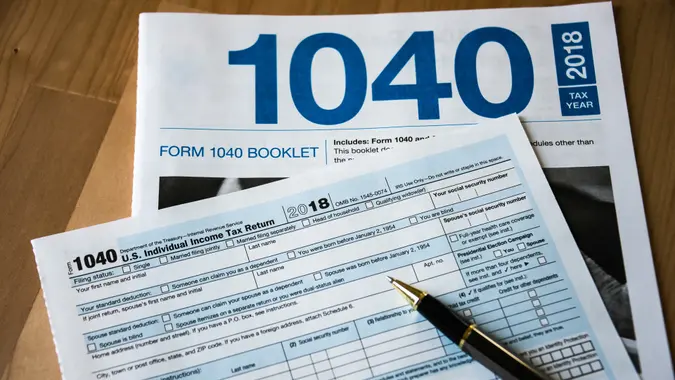Advertiser Disclosure
GOBankingRates works with many financial advertisers to showcase their products and services to our audiences. These brands compensate us to advertise their products in ads across our site. This compensation may impact how and where products appear on this site. We are not a comparison-tool and these offers do not represent all available deposit, investment, loan or credit products.
Why You Shouldn’t Assume You’re Getting a Tax Refund
 Written by
Cameron Huddleston
Written by
Cameron Huddleston

Commitment to Our Readers
GOBankingRates' editorial team is committed to bringing you unbiased reviews and information. We use data-driven methodologies to evaluate financial products and services - our reviews and ratings are not influenced by advertisers. You can read more about our editorial guidelines and our products and services review methodology.

20 YearsHelping You Live Richer

Reviewed by Experts

Trusted by Millions of Readers
Most taxpayers likely will get a refund this year. That’s because the majority of people do every year — but that doesn’t mean you automatically should count on getting a refund in 2021. For several reasons, you might not get money back or might end up owing the government this year.
Learn more about getting a tax refund, and why you might not receive one this year.
Last updated: Mar. 18, 2021
You Didn’t Have Enough Taxes Withheld
One of the most likely reasons you won’t get a refund is that you didn’t have enough taxes withheld from your paycheck during the year. “This seems to trip up married taxpayers because each fills out a W-4 separately,” said Lindsey Buchholz, a local taxpayer advocate at Taxpayer Advocate Service in North Dakota.
If the couple has children, each person might claim several allowances. Such allowances reduce the amount of tax withheld. When those parents fill out their tax forms, they might discover they didn’t have enough withheld.
Unmarried taxpayers also might fail to have enough withheld. For example, you might run into this problem if you entered the workforce in 2020 and filled out a W-4 for the first time. Perhaps you tried to pad your savings by claiming allowances to reduce your tax withholding. Or, maybe you hit a rough patch financially and adjusted your withholding temporarily to boost take-home pay, but forgot to file a new W-4 when your situation improved.
If you find that you didn’t have enough tax withheld in 2020, file a new W-4 with your employer to adjust your withholding so you don’t come up short again for 2021.
You Didn’t Pay Enough in Estimated Taxes
People who started freelancing or joined the gig economy in 2020 might not have realized that it’s necessary to make quarterly estimated tax payments. Such a mistake could cost you a refund — and might cause you to owe money to the federal government.
You have to make estimated tax payments throughout the year if you earn enough through self-employment to owe $1,000 or more when your return is filed, according to the IRS. You might be charged a penalty if you don’t make those payments.
Taking advantage of deductions for the self-employed can help lower your taxable income so you owe less, however. For example, if you work from home, you might be able to claim the home office deduction. If you used your car for business, you can deduct car or mileage expenses.
You also have until the tax filing deadline on May 17th (for 2021) to open and contribute to a traditional IRA or SEP IRA, said Mark Jaeger, director of tax development at TaxAct, a tax preparation software company. You can deduct your contributions, which will help lower your taxable income.
Please note, however, that though the IRS has announced that the federal income tax deadline for individuals is May 17 for the 2020 tax year, state deadlines have not changed. So make sure to confirm your state’s due date before you file.
Also be aware that the estimated tax you have to pay as a self-employed worker includes not only income tax, but also the self-employment tax — 12.4% for Social Security and 2.9% for Medicare. “The biggest surprise for those in the gig economy who show a profit is they have to pay self-employment tax,” said Barbara Weltman, an attorney and contributor to “J.K. Lasser’s Your Income Tax 2017.” “That’s a killer.”
You can deduct half of the self-employment tax, however. To do so, you’ll need to file a Schedule SE along with your 1040.
Your Healthcare Tax Credit Was Too Big
If you received a premium tax credit that lowered the cost of coverage through the health insurance marketplace, you might discover at tax time that the credit you got was too big. If so, you might not get a refund.
Buchholz said the credit is based on an income estimate. If your income ended up being higher than your estimate, you might have taken more credits than you qualified for, she said. If that is the case, you will need to pay it back at tax time.
When you file your return, you’ll have to pay back money to reconcile the credits you received versus the amount you qualified for based on your actual income, Buchholz said. About half of taxpayers who get the premium credit end up owing money at tax time, she said.
To avoid ending up in this situation again, Buchholz said you can take less than 100% of the credit for which you qualify based on your estimated income. If you end up taking too little of the credit during the year, you’ll get money back when you file taxes.
You Tapped a Retirement Account Before Retirement
If you took money from a retirement account — such as a 401(k) or IRA — last year before age 59 1/2, you’ll likely be hit with a 10% early withdrawal tax penalty, Weltman said. This penalty could wipe out your refund, or leave you owing money to the government.
You might be able to escape the penalty if you withdrew the money for certain purposes, however, she said. For example, you don’t have to pay the penalty on early IRA withdrawals if you used some of the money for qualified higher education expenses, or if you used up to $10,000 for the purchase of a first home.
For both an IRA and a 401(k), you don’t have to pay the penalty if you took the money out after becoming totally and permanently disabled, or to cover unreimbursed medical expenses above 7.5% of your income.
You Forgot To Take Retirement Account Withdrawals
If you have a 401(k) or traditional IRA, you must take required minimum distributions once you turn age 70 1/2. The distribution amount is based on the account balance and a life expectancy factor established by the IRS.
If you don’t take an RMD, you’ll be taxed 50% of the amount you were supposed to withdraw. The amount you owe for the penalty could end up wiping out a refund. Weltman said you might qualify for a waiver that will exempt you from the penalty, however.
The penalty might be waived if you show that you didn’t take the distribution — or a large enough distribution — due to reasonable error, according to the IRS. “They’re pretty understanding,” Weltman said.
You Didn’t Claim All of the Tax Breaks You Deserve
You might not get a refund — or you might owe money — simply because you failed to claim all of the tax breaks you deserve. For example, you might qualify for credits or deductions if you’re paying higher education costs for yourself or a child.
People who are taking courses to improve their job skills might not realize they qualify for the Lifetime Learning Credit, Buchholz said. The credit is for qualified education expenses paid for undergraduate, graduate or professional degree courses and is worth up to $2,000. Combined with other deductions — such as the student loan interest deduction — it might push you into refund territory. Other tax credits also are available for both you and your children.
You might also miss out on deductions if you don’t itemize on your tax return. Most taxpayers claim the standard deduction — just 1 in 3 itemizes, Buchholz said. But if you take the extra steps to itemize, you might get deductions that are worth more than the standard deduction.
You might even be able to take advantage of itemizing if you don’t own a home, especially if you paid high state and local taxes, paid property taxes — on a car, for example — and made large charitable donations, she said.
If you live in a state without income taxes, you can deduct sales tax, Jaeger said. Using tax software will help identify whether you’d be better off itemizing and help pinpoint credits for which you qualify.
“You wouldn’t want to lose out on the credits and deductions you are due,” he said.
You’re Not Required To File a Return, So You Don’t
You’re not required to file a tax return if your income is below a certain level — $12,200 to $27,000, depending on your age and tax status. So if you didn’t earn much, you might assume there’s no reason to file a return this year. You could end up missing out on a refund, though.
“People who may not be required to file a return may not know they’re eligible for a refund because of tax credits such as the Earned Income Credit,” Weltman said. Because this credit — which is available to low-income taxpayers — reduces the amount of taxes you owe, it can result in a refund.
If you had taxes withheld from your paycheck and qualify for the credit, you have to file a return to claim the credit, even if you’re not required to file a return otherwise. “The IRS won’t just send you a refund if you don’t file,” Weltman said.
Avoiding these mistakes and penalties might help ensure that you get a tax refund. Keep in mind, though, that getting a big refund isn’t necessarily a good thing. Although a refund feels like a windfall, it means you let the IRS withhold too much of your paycheck throughout the year.
“Financially, it makes sense for you to have the money throughout the year rather than let the government have a 16-month interest-free loan,” Jaeger said. You could invest the money each month, earn interest on it and get a bigger return over time than you would by waiting to collect a tax refund in the spring.
More From GOBankingRates
Share this article:




You May Also Like



Trump Wants To Eliminate Income Taxes: Here's How Much Extra You'd Take Home If You Make $250,000 a Year
September 30, 2025
9 min Read


I Asked ChatGPT What Would Happen If Billionaires Paid Taxes at the Same Rate as the Middle Class
September 30, 2025
9 min Read

Kevin O'Leary: Here's What You Need To Know About Trump's New Tax Bill
September 29, 2025
9 min Read

5 States Where Seniors Will See the Most Benefits from the Big, Beautiful Bill
September 26, 2025
9 min Read

I Asked ChatGPT What Would Happen If Billionaires Paid Taxes at the Same Rate as the Working Class
September 24, 2025
9 min Read


Suze Orman: How To Make the Most of the SALT Deduction To Save on Your Taxes
September 23, 2025
9 min Read



I Asked ChatGPT What Would Happen If Middle-Class Families Got the Same Tax Breaks as Corporations
September 18, 2025
9 min Read

Make your money work for you
Get the latest news on investing, money, and more with our free newsletter.
By subscribing, you agree to our Terms of Use and Privacy Policy. Unsubscribe at any time.


Thanks!
You're now subscribed to our newsletter.
Check your inbox for more details.



Sending you timely financial stories that you can bank on.
Sign up for our daily newsletter for the latest financial news and trending topics.
For our full Privacy Policy, click here.
Looks like you're using an adblocker
Please disable your adblocker to enjoy the optimal web experience and access the quality content you appreciate from GOBankingRates.
- AdBlock / uBlock / Brave
- Click the ad blocker extension icon to the right of the address bar
- Disable on this site
- Refresh the page
- Firefox / Edge / DuckDuckGo
- Click on the icon to the left of the address bar
- Disable Tracking Protection
- Refresh the page
- Ghostery
- Click the blue ghost icon to the right of the address bar
- Disable Ad-Blocking, Anti-Tracking, and Never-Consent
- Refresh the page




